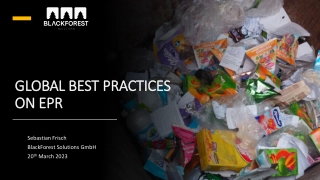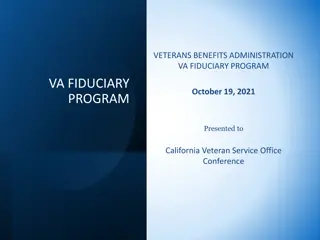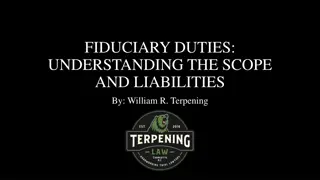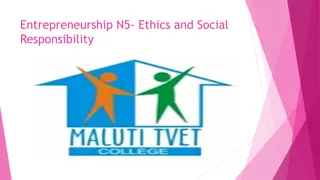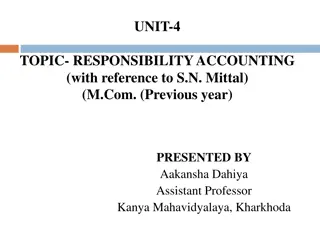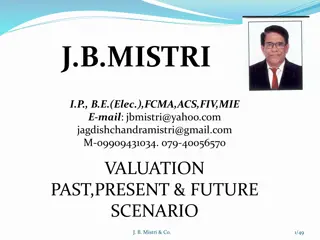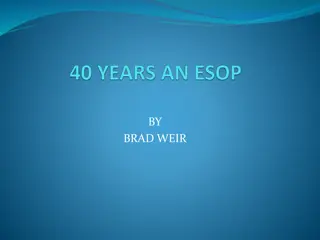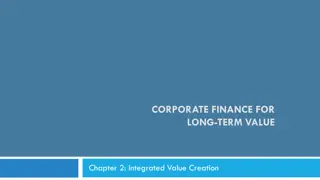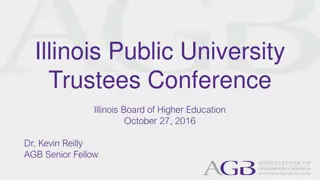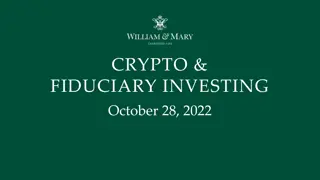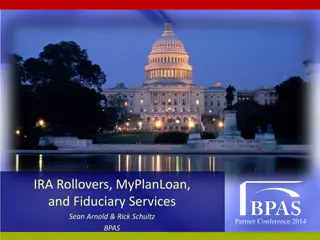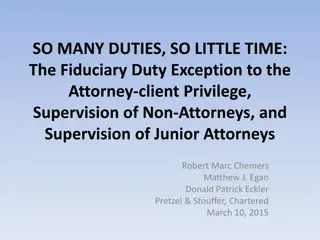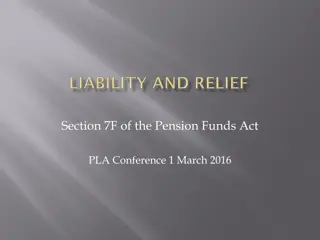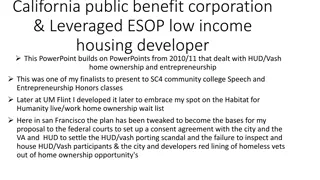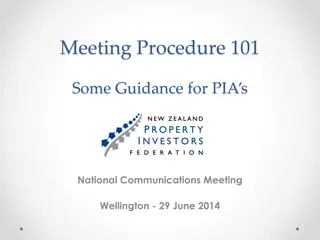Understanding ESOP Fiduciary Responsibility for Value Determination
Gregory E. Kniesel, ASA, and Emily Rickard are experts in ESOP fiduciary responsibility and valuation. Kniesel specializes in financial analysis and valuation, with vast experience in appraisals for various purposes. Rickard focuses on assisting employers in implementing ESOPs and handling related litigation. Both professionals provide valuable insights and expertise in the field of ESOPs.
Download Presentation

Please find below an Image/Link to download the presentation.
The content on the website is provided AS IS for your information and personal use only. It may not be sold, licensed, or shared on other websites without obtaining consent from the author. Download presentation by click this link. If you encounter any issues during the download, it is possible that the publisher has removed the file from their server.
E N D
Presentation Transcript
ESOP Fiduciary Responsibility for Value Determination Gregory E. Kniesel, ASA Managing Director Value Management, Inc. 770 262 7259 gek@valuemanagementinc.com Emily Rickard Associate McDermott Will & Emery LLP 202 756 8370 Erickard@mwe.com
Gregory E. Kniesel, ASA Mr. Kniesel is Managing Director of the New York office of Value Management Inc. In this capacity, he functions as a project manager responsible for financial analysis, economic analysis, and valuation of closely-held enterprises, asset-holding entities, intangible assets and publicly-traded securities. Mr. Kniesel has also prepared fair value analyses for financial reporting purposes, and served as an adviser in the purchase and sale of business enterprises. Mr. Kniesel has been actively engaged in the appraisal profession since 1989. His appraisals have been used for financial reporting purposes, estate planning, ESOPs, mergers and acquisitions, marital dissolutions, recapitalizations, dissenting stockholders' actions, estate and gift tax, and fairness opinions. Mr. Kniesel is an Accredited Senior Appraiser (Business Valuation) of the American Society of Appraisers and has served on The ESOP Association's Valuation Advisory Committee for over 15 years. He has taught business valuation courses and continuing legal education classes. Mr. Kniesel has spoken at numerous professional conferences and seminars on various business valuation topics, including ESOPs and mergers and acquisitions, and has provided expert testimony regarding business valuation issues. Mr. Kniesel has authored various articles in Valuation Strategies, The Journal of Employee Ownership Law and Finance,and Journal of Taxation.
Emily Rickard Emily has devoted a substantial portion of her practice to assisting employers in implementing and maintaining employee stock ownership plans (ESOPs). She advises employers in connection with government audits with respect to ESOPs, and also with respect to litigation from regulatory enforcement actions. Emily has represented outside ESOP trustees in several buy-side and sell-side transactions. As an associate at McDermott Will & Emery LLP, Emily s practice spans a wide range of national and international employee benefits matters. This includes qualified plans, nonqualified plans, executive compensation, health and welfare arrangements, and Employee Retirement Income Security Act (ERISA) litigation. Emily regularly writes and speaks on issues she encounters in her practice, including investment menu design, multiple employer plans, the history of ERISA, and ERISA s fiduciary obligations. Emily is a contributor to the Bloomberg Bureau of National Affairs (BNA) Tax Management Portfolio 354 ESOPs and BNA Corporate Practice Portfolio 62 ESOPs in Corporate Transactions.
Circular 230 Disclosure This communication is provided as a general informational service. It should not be construed as, and does not constitute, legal advice on any specific matter, nor does this message create an attorney-client relationship. To comply with requirements imposed by the Internal Revenue Service ( IRS ), McDermott Will & Emery LLP must inform all attendees that any U.S. Federal Tax advice contained in this communication is not intended or written to be used, and cannot be used, for the purpose of: (i) avoiding penalties under the IRS; or (ii) promoting, marketing or recommending to another party any transaction or matter addressed herein.
Legal and Regulatory Framework The Employee Retirement Income Security Act of 1974 (ERISA) generally requires relying upon the work of an independent appraisal expert. If a fiduciary relies on an inadequate appraisal, that fiduciary can breach its duties and/or violate ERISA s prohibited transaction rules.
Fiduciary Duties Loyalty ( Exclusive Benefit Rule ) Care ( Prudent Person Rule ) Diversify ESOPs generally exempt Follow Plan Documents Avoid Prohibited Transactions Prevent Co-Fiduciary Violations
Fiduciary Standard of Conduct According to the courts, fiduciaries are held to the highest standards of conduct: ERISA imposes the highest standard of conduct known to the law Reich v. Valley National Bank of Arizona Not honesty alone, but the punctilio of an honor the most sensitive, is then the standard of behavior Meinhard v. Salmon A pure heart and an empty head are not enough to defend against a fiduciary breach Donovan v. Cunningham
Fiduciary Conduct Expected When Maintaining compliance with legal requirements Administrative valuation! Making investment decisions Selecting service providers Monitoring the performance of service providers Establishing roles and duties of service providers Allocating fiduciary responsibility Communicating with participants
Prohibited Transactions No self dealing No conflict of interest transactions Specific prohibited transactions with a party in interest as defined in ERISA ESOP loans Sale, exchange, or leasing of any property Lending of money or extension of credit Furnishing of goods, services, or other facilities Transfer or use of any assets of the plan Acquisition of any employer property or securities unless certain conditions are met
Reliance on Experts Fiduciary, not expert, responsible for decision-making Fiduciary must: Investigate expert s qualifications Ensure expert has complete information about various valuation inputs Ensure that reliance on expert is reasonably justified under the circumstances Read and understand expert valuation reports Identify, question, test underlying data Verify internal consistency of expert report o Verify that conclusion is consistent with data and analysis
Process is the Key to Prudence Process is the key to demonstrating prudence Maintain written record of process Carefully select expert advisers Understand expert s advice before following the advice o Reasonable inquiries into the expert s recommendations o Blind reliance on counsel or other experts is no defense Fiduciaries do not need to have a crystal ball Even if a decision turns out badly, liability can be avoided if the process was correct Even good results could theoretically create liability if the process was bad
Process Agreements Provide helpful insight into the Department of Labor (DOL) position regarding what is required to meet fiduciary obligations under ERISA when engaging in an ESOP transaction. Process agreements have neither the force of law nor the ability to change any current laws or regulations. First introduced by the Department of Labor (DOL) in the 2014 settlement of Perez v. GreatBanc Trust Co., the process agreements have been modified and expanded Acosta v. First Bankers Tr. Servs., Inc., Acosta v. BAT Masonry Acosta v. Mueller
In-Depth Reviewing of the Valuation Report What should be in the report? (USPAP, IRS, and DOL impact) What type of questions should the Trustee be asking? Possible red flags in the valuation process
Uniform Standards of Professional Appraisal Practice USPAP Standards Rule: Business Appraisal, Reporting Requirements: Identity of client and any other intended users; Intended use of appraisal; Summarize information sufficient to identify the business; Elements of ownership control; Elements of marketability and/or liquidity; Standard, definition, and premise of value; Effective date of appraisal and date of report; Summarize the scope of work; Summarize information analyzed, procedures, and reasoning; State assumptions and hypothetical conditions, and: Signed certification
Revenue Ruling 59-60 Factors the Financial Advisor should consider: The nature and history of the business; The general economic outlook and the business specific industry; The book value and financial condition of the business; The earning capacity of the business; The dividend-paying capacity of the business; The nature and value of the tangible and intangible assets (goodwill) of the business; Sales of the subject stock and the size of the block of stock to be valued; and The market price of securities of publicly traded corporations engaged in the same or similar lines of business
Proposed Regulation Adequate Consideration Report Requirements Identity of client and any other intended users; Purpose of valuation; Relative weight given to relevant valuation methodologies; Valuation s effective date; References Revenue Ruling 59-60 and its requirements; Assess the degree of marketability of the subject securities; and Assess whether or not the ESOP would be able to obtain a control premium from and unrelated third party with regard only to the block of stock held or to be purchased by or from the ESOP.
Valuation and Process ERISA Section 3(18) defines adequate consideration as the fair market value, determined in good faith by a fiduciary, pursuant to the terms of the plan and DOL regulations Valuation Approaches Income Approach (discounted cash flow DCF ) Market Approach (Guideline public company method GPM, guideline transaction method GTM ) Asset Approach Valuation Inputs Financial statements Projections (prepared by management) Other subject company information & characteristics Comparable public or private company data Economic and market data Strength of management, product and business model Risks and opportunities Other strengths and weaknesses
Due Diligence Process for Determining Value Interview Senior Management Coordinate Site Visit with Financial Advisor Understand: Drivers of value; Quality of projections; Operations; Strategic initiatives; Customer concentration; Financial outlook; History of company; Offers to buy/sell; Board/Management composition and changes; Litigation; Banking relationship; Executive compensation; Repurchase obligation and funding strategy
Common Fiduciary Fumbles Failure to avoid actual or potential conflicts of interest particularly advisors Distributing misleading information about investments Use of plan assets by a fiduciary for personal or company benefit Unreasonable or unrealistic growth projections Unreliable or stale financials Inconsistencies buying too high/selling too low Incomparable comparables Inappropriate adjustments to financial statements Disregard/lack of knowledge of previous valuations Control premiums and marketability discounts Fiduciary with appropriate knowledge to evaluate/monitor
Questions the Trustee Should Be Asking Does the financial advisor (appraiser) have significant ESOP experience? Does the financial advisor (appraiser) adhere to USPAP? Is the financial advisor (appraiser) familiar with the DOL s proposed regulation, ESOP and valuation case law, regulations, and rulings, and recent best practices? Do the methodologies utilized make sense to you? Do the financial statement adjustments (if any) make sense to you? How do the company s accounting methods impact the valuation? Do the conclusions make sense? How did the financial advisor consider the TCJA of 2017? ESPECIALLY IF YOU ARE NOT A VALUATION EXPERT OR PROFESSIONAL TRUSTEE, ASK QUESTIONS.
Questions the Trustee Should Be Asking How were financial projections developed and are they reasonable? How were public company comparables chosen and how does the subject company compare to them? Relative capitalization multiples? Were industry acquisitions considered? Are the acquired companies comparable (business, size, etc.)? How old are the acquisitions? What methods were considered and rejected? Of the methods used in the final analysis, do you understand the differences and what factors lead to the differing results? What is the rationale for weighting the different indications of value? What discounts/premiums were applied and why?
Questions the Trustee Should Be Asking Are the same valuation approaches and methods being utilized as in prior valuation reports? Are the valuation approaches and methods applied consistently? Is the current weighting of the valuation approaches and methods similar to prior valuation reports? If changes have occurred, are the reasons sufficiently understood? What might we expect next year? What can we do to increase stock value? Are the same discounts/premiums being applied? Minority Interest Discount/Controlling Interest Premium Discount for Lack of Marketability Big Picture: Can you explain the analysis and conclusion?
Possible Red Flags in the Valuation Process Failure of financial advisor to execute engagement agreement with trustee Failure to perform appropriate due diligence with management Failure of trustee to review valuation and process Mathematical errors Missing numbers or inaccurate calculations Improper consideration of different classes of stock Warrants, options, or other synthetic equity improperly considered Increasing value with decreasing fundamentals (or the reverse) Incorrect share number utilized Using only allocated shares Using weighted-average shares instead of actual shares A POORLY WRITTEN REPORT MAY IMPLY A POORLY PREPARED ANALYSIS
Possible Red Flags in the Valuation Process Market Approach Improperly applying large company multiples to small, private companies Using pre-tax multiples to capitalize after tax metrics (or vis versa) Using enterprise multiples to value a minority interest without proper adjustment (or vis versa) Poor public company or acquired company comparables
Possible Red Flags in the Valuation Process Income Approach Basis for discount rate determination incorrect or not provided Lack of projection due diligence by financial advisor Uncharacteristically high or low cost of capital rates Capital structure improperly considered Inconsistent relationship between capital expenditures and depreciation (particularly post-TCJA)
Final Thoughts Determine that the financial advisor s opinion is consistent with the report or the opinion letter and supporting documentation relied upon by the financial advisor Identify, question, and test assumptions that underlie that valuation opinion Verify that the financial advisor s valuation opinion is consistent with the data reviewed and the analysis itself Ask the financial advisor any questions that may help you understand that analysis and the report
Dont Forget! Please fill out your evaluation for this session!


